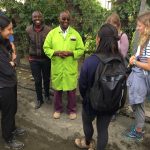By Joaquin, Savi and Wenxi
This morning breakfast was scheduled for 8am, although a few people woke early to do some bird watching. Wenxi and Karen disappeared into the bush where they spotted a White-headed barbet for the first time this trip. The barbet was on Steve’s ‘to find’ list, and (mostly) everyone was very excited about their find. Evelyn stayed by the lakeshore where she spotted a Yellow-billed stork for the first time on the course, as well as sighting an African Drongo. While Savi saw the vervet monkeys attempt to raid the campsite, and desperately chased them away. Slowly, the rest of the class trickled out of their tents for a later than normal breakfast, which was as always, amazing. We had a short break after eating and drinking excessive amounts of Chenzen’s chai before we hopped on the bus and were on our way to Florensis flower farm.
Half of an hour late, we arrived at the site and were welcomed by employees, John and George. Florensis is one of the many flower farms in the Lake Naivasha region, reflecting this booming industry in the past 20 years. The farm is owned by V. D. Berg, a multination company based in the Netherlands and currently has over 1, 000 workers. With 28 varieties of rose growing in 17 greenhouse blocks (all together 7 hectares in area), Florensis is a formidable sight. Each day, over 500, 000 stems of roses are harvested in three patches: morning, noon and early afternoon. The stems will then go through quality check and grading process. Wrapped rose bunches will be stored in cold room (5.5 degrees C) for 24 hours before shipping away, mainly to Europe via Holland, but also to the USA and Canada, and other countries. Not far away from the farm, there is the Nairobi airport from where roses in tropical Kenya reach out to the world. To our amazement, each bunch of rose would be labelled with an employee ID and should quality issues arise the company would be able to keep track. On a side note, the farm is moving towards hydroponics with one small experimental field. Growing roses in certain medium (such as liquid or sand but not soil) with specialized nutrient supplements, the hydroponics technique would potentially reduce water usage for flower farming, albeit fairly expensive at the current stage of development. Besides water exploitation, pesticides and chemicals used in this industry also cast shadows on the sustainable development of Lake Naivasha region. These issues were subsequently discussed in the afternoon.
In the afternoon’s debrief discussion we referred back to the informative lecture given by Dr. Francis Mwuara. We first talked about some of the environmental issues, locally and globally that affect lakes like Lake Naivasha. For example, we talked about eutrophication and the effects of invasive species. We then discussed some of the socioeconomic issues that affect many Kenyans. We talked about the differences in wages internationally and even the need for policy to include, more broadly, rights like maternity leave. We were lucky to have Carol to illustrate and clarify some of the processes of implementation and oversight on environmental policy. We finally talked about water management issues and how, in Johannesburg, South Africa they are already having to deal with the scarcity of water. This is an issue that does not affect Canadian’s as much but it was enlightening to learn about, especially with the increasing importance of this issue globally. After this, we had some free time followed by some more hippo sightings, with the night culminating with a delectable dinner. We went to bed early for another adventure-filled day tomorrow.
Click on the thumbs to view a larger image
- QC flowers, partnered with individual shipments to Europe to ensure quality
- Niches of roses ready for shipment in cold room
- Our hosts at the flower farm
- QC, grading, sorting and packaging floor




Leave a Reply